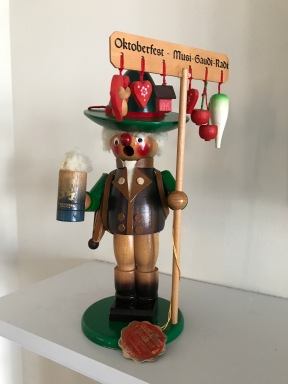For me, the Christmas Season begins with the re-emergence of my Steinbach Smoking Men. Out comes “The Real Bavarian,” “The Mushroom Man,” “The Bunny Rancher,” and all the rest. Each adorable folk character is an incense burner. Some are also music boxes playing German folk tunes.  Their bodies come apart in the middle where you place a cone of incense, light it, put them back together, and then watch the smoke spiral up out of their open mouths.
Their bodies come apart in the middle where you place a cone of incense, light it, put them back together, and then watch the smoke spiral up out of their open mouths.
For thousands of years the burning of incense has been used in religious rituals. The rising smoke is symbolic of offerings and prayers rising up to Heaven. At Christmas time we are reminded of the “three wise men” or Magi,  who brought precious gifts of gold, frankincense and myrrh from the Far East. Frankincense and myrrh are both aromatic resins used to make incense and perfumes. They were costly exotic commodities that flowed along trade routes for centuries out of Africa and the Arabian Peninsula.
who brought precious gifts of gold, frankincense and myrrh from the Far East. Frankincense and myrrh are both aromatic resins used to make incense and perfumes. They were costly exotic commodities that flowed along trade routes for centuries out of Africa and the Arabian Peninsula.
But for as many years, incense has been an important part of pagan rituals. It was burned in sacrifices, and used to purify the home and drive out evil spirits, as well as to draw in good luck and good fortune. Long before Christmas, ancient Peoples celebrated the Winter Solstice, the longest night and shortest day of the year. 
Because the Solstice marks the meteorological turning point of that trend, numerous rituals of fire and light became associated with what must have seemed a magical time of the year to ancient agrarian cultures. As most of us know, these pagan rituals eventually merged with many Christian Christmas traditions.
Christian and Germanic customs together with superstition made people believe that the evil spirits of the “Raunaechte” (longest nights of the year) could be driven away by noise and light. Once the devils and evil spirits had left the house fine incense was burnt to bless hearth and home. Written in chalk over the front door would be the letters C+M+B believed to be a magic spell that would keep evil away throughout the coming year. The letters stood for: Caspar, Melchior, and Balthasar, traditionally the three names given to the Magi.
As medieval piety grew in Germany in the 1600’s, folk artists created new forms to burn incense that were religiously acceptable. In particular, toy makers in the Erzgebirge region, (the Ore Mountains), began to carve wooden folk characters that were also incense burners and thus the “smoking men” were born.
The Steinbach family has been making German folk art for 5 generations. They proudly manufacture these “smokers” in charming detail. Few stores in the U.S. import them but if you visit one of the many European Christmas markets this time of year, you will have many to choose from!
Dear readers, do you have an event or ritual that marks the beginning of the Christmas season for you? Would you care to share it with us?








Par excellence!
Sent from my iPad
>
LikeLike
Thanks Phyllis. Glad you liked it.
LikeLike
love the smokers!!!
LikeLike
Yes, it’s just not Christmas to me without them! Wish you were here to enjoy them with me!
LikeLike
These are wonderful!
LikeLike
Yes, they are very special. You’ll have to come and see them in person Anne
LikeLike
They remind me of those puppets in The Sound of Music. Truly intricate, aren’t they.
LikeLike
yes, you’re right, very Tyrollean!
LikeLike